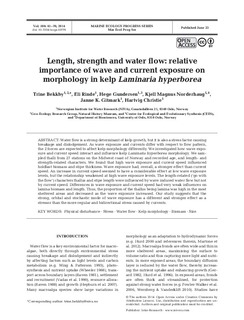Length, strength and water flow: relative importance of wave and current exposure on morphology in kelp Laminaria hyperborea
Bekkby, Trine; Rinde, Eli; Gundersen, Hege; Norderhaug, Kjell Magnus; Gitmark, Janne K.; Christie, Hartvig
Journal article, Peer reviewed
Permanent lenke
http://hdl.handle.net/11250/196840Utgivelsesdato
2014Metadata
Vis full innførselSamlinger
- Scientific publications [1166]
Originalversjon
Bekkby, T. et al., 2014. Length, strength and water flow - the relative importance of wave and current exposure on kelp Laminaria hyperborea morphology. Marine Ecology Progress Series (506) 61-70. 10.3354/meps10778Sammendrag
Water flow is a strong determinant of kelp growth, but it is also a stress factor causing breakage and dislodgement. As wave exposure and currents differ with respect to flow pattern, the 2 forces are expected to affect kelp morphology differently. We investigated how wave exposure and current speed interact and influence kelp Laminaria hyperborea morphology. We sampled thalli from 27 stations on the Midwest coast of Norway and recorded age, and length- and strength-related characters. We found that high wave exposure and current speed influenced holdfast biomass and stipe thickness. Wave exposure had, overall, a stronger effect than current speed. An increase in current speed seemed to have a considerable effect at low wave exposure levels, but the relationship weakened at high wave exposure levels. The length-related (‘go with the flow’) characters thallus and stipe length were influenced by wave induced water flow but not by current speed. Differences in wave exposure and current speed had very weak influences on lamina biomass and length. Thus, the proportion of the thallus being lamina was high in the most sheltered areas and decreased as the wave exposure increased. Our study suggests that the strong, orbital and stochastic mode of wave exposure has a different and stronger effect as a stressor than the more regular and bidirectional stress caused by currents.

